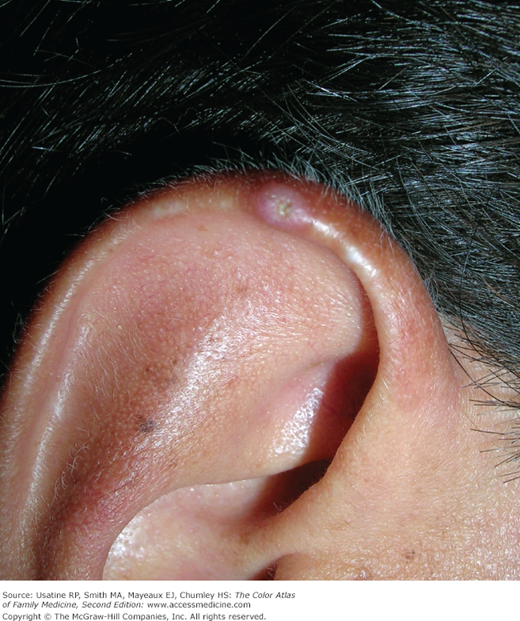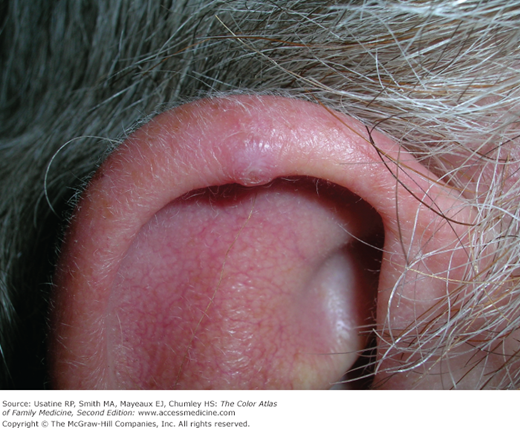Patient Story
A 44-year-old white man presents with a painful nodule on his right ear for 1 year (Figure 29-1). He has a long history of occupational sun exposure but no skin cancers. He states that it is too painful to sleep on his right side because of the ear nodule. He tried to remove it once with nail clippers but it bled too much. The patient is told that this is likely a benign condition called chondrodermatitis nodularis helicis. A shave biopsy/removal is performed for diagnostic and therapeutic purposes. It is explained to the patient that this could be a skin cancer as a result of his sun exposure history. The biopsy confirms chondrodermatitis nodularis helicis and he is counseled to use sun protection.
Introduction
Chondrodermatitis nodularis helicis is a benign neoplasm of the ear cartilage commonly believed to be related to excessive pressure, for example, during sleep, and sun exposure. The result is a localized overgrowth of cartilage, and subsequent skin changes. Preauricular tags are malformations of the external ear.
Epidemiology
- The incidence of chondrodermatitis nodularis has not been determined.
- Occurs most commonly in men older than 40 years of age, but older women can also be affected.
- Occur in approximately 1 of 10,000 to 12,500 births without predilection for gender or race.
- Ear malformations may occur in isolation or as part of a constellation of abnormalities, often involving the renal system. Children have a 5-fold risk of hearing impairment (8 of 10,000 vs. 1.5 of 10,000).1
- Several chromosomal abnormalities include preauricular tags as one of the phenotypic expressions.
- The Goldenhar syndrome includes preauricular skin tags, bilateral limbal dermoids of the eye and eyelid colobomas (Figure 29-2).
Etiology and Pathophysiology
- In rare cases, especially when occurring at younger ages, the lesion may be related to an underlying disease associated with microvascular injury, such as vasculitis or other necrobiotic collagen disease.2
- Arise from remnants of supernumerary brachial hillocks.3
- Early stage embryology involves the formation of several slit-like structures on the side of the head, the branchial clefts. The three hillocks between the first four clefts eventually form the structure of the outer ear. Preauricular tags are generally minor malformations arising from remnants of supernumerary branchial hillocks.4
Diagnosis
- Firm, painful nodule 3-20 mm in size (Figures 29-1, 29-2, 29-3, and 29-4).
- The helix is most often affected especially in men (Figures 29-1 and 29-2). The antihelix is affected more often in women (Figures 29-3 and 29-4).
- Overlying skin normal in color or erythematous; a central ulcer may be present.
Stay updated, free articles. Join our Telegram channel

Full access? Get Clinical Tree




